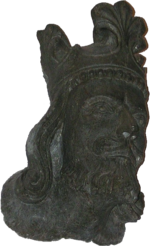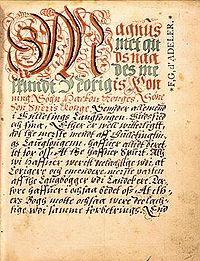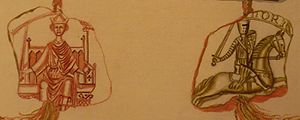- Magnus VI of Norway
-
Magnus VI Lagabøte 
King of Norway Co-reign
Solo-reign1257-1263
1263–1280Coronation 14 September 1261, Bergen Predecessor Haakon IV & Haakon the Young Successor Eric II Senior King
Junior KingHaakon IV
Eric IIConsort Ingeborg Eriksdotter
m. 1263; wid. 1280Issue Olav (1262–1267)
Magnus (1264–1264)
Eirik II of Norway (1268–1299)
Haakon V of Norway (1270–1319)House Fairhair Father Haakon IV of Norway Mother Margrét Skúladóttir Born 1 May 1238
TønsbergDied 9 May 1280
BergenBurial Bergen Cathedral, Bergen Religion Roman Cahtolicism Norwegian Royalty House of Sverre Magnus VI Children Olav Magnusson Magnus Magnusson Eric II Haakon V Magnus VI Lagabøte (Old Norse: Magnús lagabœtir, English: Magnus the law-mender) or Magnus Håkonsson (Old Norse: Magnús Hákonarson) (1 May 1238 – 9 May 1280), was king of Norway from 1263 until 1280.[1]
Contents
Early life
He was the youngest son of King Håkon Håkonsson and his wife Margaret Skuladotter. He was born in Tunsberg and was baptised in May 1238. He spent most of his upbringing in Bergen. In 1257 his older brother Håkon died, leaving Magnus the heir-apparent to the kingdom. His father gave him the title of king the same year. On 11 September 1261, he married the Danish princess Ingeborg, the daughter of the late Danish King Erik Plogpenning, after she was practically abducted by King Håkon's men from the monastery she was living in. The struggle to claim Ingeborg's inheritance from her murdered father later involved Norway in intermittent conflicts with Denmark for decades to come. Magnus and Ingeborg were crowned directly after their marriage, and Magnus was given Ryfylke for his personal upkeep. On 16 December 1263 King Håkon died while fighting the Scottish king over the Hebrides, and Magnus became the ruler of Norway.
Reign
Foreign policy
Magnus' rule brought about a change from the somewhat aggressive foreign policy of his father. In 1266 he gave up the Hebrides and the Isle of Man to Scotland, in return for a large sum of silver and a yearly payment, under the Treaty of Perth, by which the Scots at the same time recognised Norwegian rule over Shetland and the Orkney Islands.[2] In 1269 the Treaty of Winchester cemented good relations with the English king Henry III.[3] Magnus also seems to have had good relations with the Swedish King Valdemar Birgersson, and in the 1260s, the border with Sweden was officially defined for the first time. When Valdemar was deposed by his two brothers and fled to Norway in 1275, this stirred Magnus into gathering a leidang-fleet for the first and only time in his reign. With a large fleet, he met with the new Swedish King Magnus Ladulås to try to bring about a settlement between the two brothers, but without success, Magnus of Sweden would not give in to pressure and the Magnus of Norway retreated without engaging in hostile actions.
Internal policies
In internal politics, Magnus carried out a great effort to modernise the law-code, which gave him his epithet law-mender. These were adopted at the Things in the years 1274 (Landslov) and 1276 (Byloven). In 1274 he promulgated the new national law, a unified code of laws to apply for the whole country, including the Faroe islands and Shetland. This replaced the different regional laws which had existed before. It was supplemented by a new municipal law (a law for the cities) in 1276, and a slightly modified version was also drawn up for Iceland. A unified code of laws for a whole country was at this time something quite new, which had until then only been introduced in Sicily and Castile. His code introduced the concept that crime is an offense against the state rather than against the individual and thus narrowed the possibilities of personal vengeance. It increased the formal power of the king, making the throne the source of justice. The municipal law gave the cities increased freedom from rural control. A specific section fixed the law of succession to the throne, in accordance with the arrangements laid down by King Håkon Håkonsson in 1260.[4]
The royal succession was an important and prickly matter, the last of the civil wars, fought for decades over disputed successions to the throne, having finally ended only in 1240. In 1273 Magnus gave his eldest son, five-year-old Eirik, the name of king, and his younger brother Håkon the title of duke, thus making unequivocally clear what the royal succession would be.
Although Magnus was by all accounts a personally very pious king, his work with the law-codes brought him into conflict with the archbishop, who resisted temporal authority over the church, and sought to preserve the churches influence over the kingdom. The Tønsberg Concord (Sættargjerden in Tønsberg) signed in 1277 between King Magnus and Jon Raude, Archbishop of Nidaros, confirmed certain privileges of the clergy, the freedom of episcopal elections and similar matters. The church preserved considerable independence in judicial matters, but gave up its old claim that the Norwegian kingdom was a fief under the ultimate authority of the Catholic Church.[5]
In cultural terms Magnus continued his father's policy of introducing European courtly culture to Norway. In 1277 he replaced the old Norse titles lendmann and skutilsvein with the European titles baron and riddar (knight), at the same time giving them certain extra privileges and the right to be addressed as lord (herra). Magnus is probably also the first Norwegian king to have named himself using an ordinal number - he called himself Magnus IV. Immediately after his father's death, he commissioned the Icelander Sturla Þórðarson to write his father's saga, or biography. In 1278, he commissioned the same man to write his own saga. The Saga of Magnus the lawmender (Magnúss saga lagabœtis) thus became the last of the medieval Norwegian kings' sagas, unfortunately only a short fragment of it has been preserved.
Death and aftermath
In the spring of 1280, Magnus fell ill in Bergen and died 9 May. He had already planned to have his son Eirik crowned at midsummer as co-ruler, instead Eirik now took over as sole king at the age of 12. Real power fell to a circle of advisors, prominent among them Magnus' queen Ingeborg. Magnus was remembered as a good ruler, who ruled by law rather than by the sword. Some modern historians have considered him a weak king, for giving up the Hebrides and giving in to demands of the church,[6] but others consider these wise policies, sparing the kingdom unnecessary and unfruitful wars abroad, while preserving stability at home. Magnus was buried in the church of the Franciscan monastery in Bergen, which has since the 16th century been the Bergen Cathedral (Bergen Domkirke).
Ancestry
Ancestors of Magnus VI of Norway 16. Unås (claimed Sigurd II of Norway) 8. Sverre of Norway 17. Gunnhild 4. Haakon III of Norway 18. Roe 9. Astrid Roesdatter 2. Haakon IV of Norway 5. Inga of Varteig 1. Magnus VI of Norway 24. Guttorm Åsulvsson 12. Bård Guttormsson 25. Sigrid Torkjellsdotter 6. Skule Bårdsson 26. Erling from Kviden 13. Ragnfrid Erlingsdotter 27. Skårvangsola 3. Margrét Skúladóttir 14. Jon Torbergsson 7. Ragnhild Jonsdotter 30. Erling Skakke 15. Ragnhild Erlingsdotter 31. Kristin Sigurdsdatter References
- ^ Magnus 6 Håkonsson Lagabøte – utdypning(Store norske leksikon)
- ^ Full original text of the treaty, from Diplomatarium Norvegicum (in Latin)
- ^ Full original text of the treaty, from Diplomatarium Norvegicum (in Latin)
- ^ Magnus Lagabøtes landslov (Store norske leksikon)
- ^ Sættargjerden i Tunsberg (Store norske leksikon)
- ^ e.g. Oscar Albert Johnsen, Noregsveldets undergang (Kristiania, 1924)
Other sources
- Sturla Þórðarson; translation to English by G.W. Dasent (1894, repr. 1964). The Saga of Hakon and a Fragment of the Saga of Magnus with Appendices. London (Rerum Britannicarum Medii Ævi Scriptores, vol.88.4).
- Knut Helle (1974). Norge blir en stat, 1130–1319, pp. 134–146. Universitetsforlaget.
Magnus VI of NorwayCadet branch of the Fairhair dynastyBorn: 1238 Died: 9 May 1280Regnal titles Preceded by
Haakon IVKing of Norway
1257–1280
with Haakon IV (1257-1263)
Eric II (1273-1280)Succeeded by
Eric IICategories:- Norwegian monarchs
- Fairhair dynasty
- 1238 births
- 1280 deaths
- People from Tønsberg
- Burials at Christ Church, Bergen
Wikimedia Foundation. 2010.


